|
==============================================================================
TOPIC: Bradley Fork, GSMNP
http://groups.google.com/group/entstrees/browse_thread/thread/8589d7ce1351de46?hl=en
==============================================================================
== 1 of 1 ==
Date: Thurs, Aug 7 2008 9:06 pm
From: "Jess Riddle"
Ents,
On Memorial Day, Michael Davie and I visited a series of east-facing
coves along Bradley Fork in the Oconaluftee section of Great Smoky
Mountains National Park. The coves rapidly descend from near 4000'
elevation on Richland Mountain becoming incised between spur ridges
before entering broad, gentle slopes and meeting Bradley Fork at
2600'
elevation. On the opposite side of Bradley Fork, Mine Ridge also
rises steeply to just under 4000', so topography shelters the cove
from both easterly and westerly winds. Given that terrain, and the
exceptionally tall black locust and tuliptree in coves further up
and
down Bradley Fork respectively, we anticipated rich forest with tall
hardwoods, especially tuliptree.
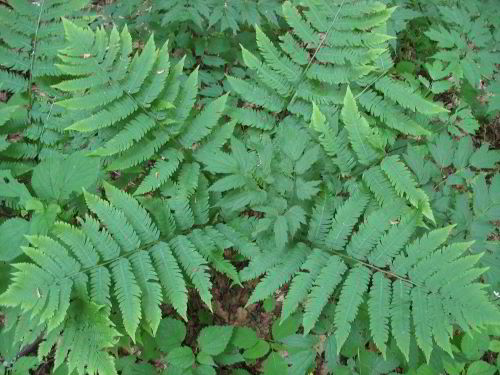
Goldies fern arching over black cohosh |

A typical section of forest floor on the rich slopes.
Wild
geranium, stinging nettle, wild ginger, goldenrod, Canada
violet,
black cohosh, blue cohosh, and water leaf are visible in the
image. |
A dense herbaceous layer dominated by wild geranium, black cohosh,
blue cohosh, stinging nettle, and Canada violet carpets the forest
floor on the gentle slopes at the lower ends of the coves. Above
that
layer, an overstory of second-growth tuliptree with occasional white
basswood, black locust, and beech provides shade, and yellow buckeye
with smaller numbers of silverbell and sugar maple fill in the
understory.
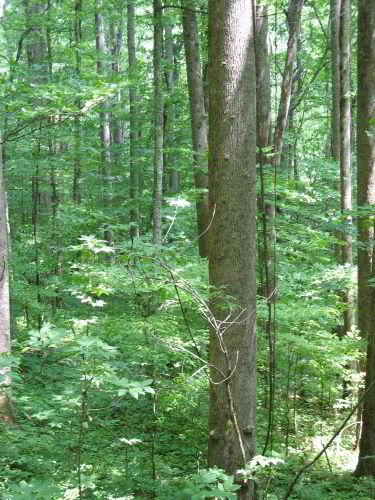
A typical tuliptree dominated section of forest. |
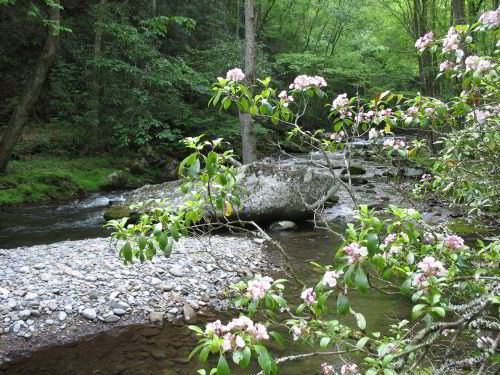
Kalmia_latifolia: Mountain laurel overhanging Bradley
Fork.
|
The largest stream draining the area supported slightly
drier forest with more oaks, but the more shaded coves supported
similarly rich forest that also included bitternut hickory in the
canopy. While the density of the herbaceous layer and composition of
the overstory resemble many other rich coves in the Smokies, the
richest sections of the coves also included several species unusual
for the park; goldie's fern spread above the surrounding herbs, and
glade fern, larkspur and paw paw occurred in a few small patches.
Species Cbh Height
Buckeye 8'3" 129.9'
Buckeye 7'4.5" 130.6'
Locust, Black 150.5'
Sassafras 7'8" 125.5'
Sassafras 6'3" 129.2'
Sassafras 6'6.5" 130.7'
Tuliptree 10'5" 164.3'
Tuliptree 8'6" 165.2'
Tuliptree 7'8" 165.3'
Tuliptree 12'2.5" 166.2'
Tuliptree 7'5" 167.4'
Tuliptree 7'5.5" 168.6'
Tuliptree 8'1" 170.6'
The buckeyes are not exceptionally tall for the species, but they
are
unusually tall for second-growth individuals of highly shade
tolerant
species. Black locust has now been measured to 150' tall at six
sites
in the Oconaluftee River watershed; I know of only three other sites
with black locust over 150'.
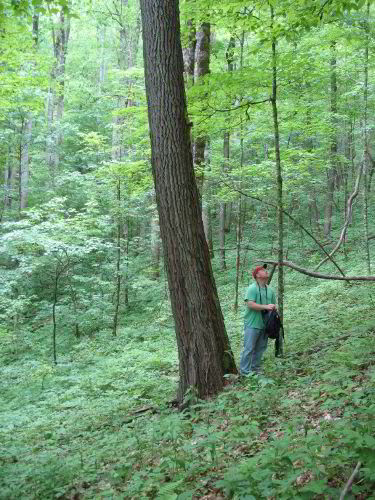
7'8" cbh x 125.5' tall sassafras.
|
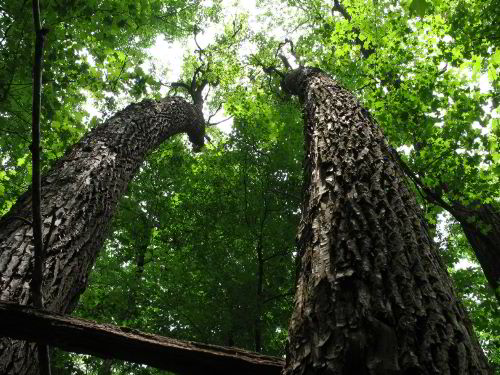
6'3" x 129.2' sassafras and 6'6.5" x 130.7'
sassafras. |
The sassafras shatters the previous
height record of 121.4' held by a tree in Georgia. All three grow
within sight of each other on a drier slope dominated by northern
red
oak and red maple, but they are also within 50 yards of a cluster of
165'+ tuliptrees in the cove bottom. Other tuliptrees in the area
almost certainly exceed 170', but the summertime conditions made
finding the highest points difficult.
Jess Riddle & Michael Davie
==============================================================================
TOPIC: Bradley Fork, GSMNP
http://groups.google.com/group/entstrees/browse_thread/thread/8589d7ce1351de46?hl=en
==============================================================================
== 1 of 4 ==
Date: Fri, Aug 8 2008 5:32 am
From: dbhguru@comcast.net
Jess and Mike,
Congratulations. The Smokies are so dominant when it comes to
super-canopy height. The more we learn, the more the Smokies stand
out. Your discoveries are inspiring.
Bob
== 2 of 4 ==
Date: Fri, Aug 8 2008 6:58 am
From: James Parton
Michael & Jess,
I have never seen a Sassafras over 100 feet tall. Cool! Nice Locusts
and Buckeyes too.
James Parton.
== 3 of 4 ==
Date: Fri, Aug 8 2008 3:36 pm
From: Lee Frelich
Jess:
Are you sure it was stinging nettle growing in with the blue cohosh
and
Canada violets, as opposed to wood nettle (which can also sting)?
Its pretty rare for you to make a mistake.
I have never seen a Goldies fern. They are exceptionally rare here.
I will
have to make sure I see one next time I visit the Smokies.
Lee
== 4 of 4 ==
Date: Fri, Aug 8 2008 5:19 pm
From: "Jess Riddle"
Hi Lee,
Common names are causing problems again. Down South Laportea
canadensis usually goes by the common name stinging nettle. Do you
reserve the name stinging nettle for the Urticas?
Goldies fern is impressively large, and worth a trip to see.
However,
the Smokies might not be the best place; I've only seen the species
in
the park twice. I've actually seen it more often in central New
York.
It seems to do well in the limestone derived soils around here.
Jess
==============================================================================
TOPIC: Bradley Fork, GSMNP
http://groups.google.com/group/entstrees/browse_thread/thread/8589d7ce1351de46?hl=en
==============================================================================
== 1 of 1 ==
Date: Sat, Aug 9 2008 3:34 pm
From: Lee Frelich
Jess:
Yes, we reserve the name stinging nettle for the Urticas, which
don't grow
in shady places.
We have some forests on silty soil with so much wood nettle (Laportea
canadensis) that you can 'swim' through it. Its not much fun unless
you are
wearing a rubber raincoat to shed all the stinging fluid.
Goldies fern has been on my list of plants that I have not seen yet,
but
would like to add to my life list, along with giant horse tail,
Hart's
tongue fern and a few others.
Lee
|